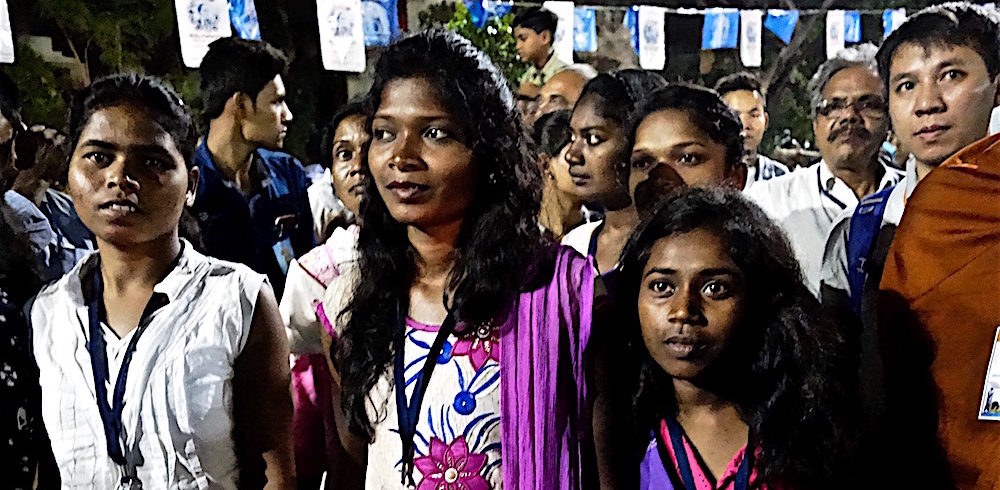Posted on March 8, 2011 by Alan Senauke
India 2011, #3

8 March 2011
I am back at Nagaloka in Nagpur after three days in Mumbai, the start of our Think Sangha study tour. Although I only left Nagaloka three days ago, it felt almost like a homecoming to return.
Arriving with the group, the students and staff met us at the gate with garlands and showers of blossoms.
“Think Sangha” evolved in the mid-90s as a Buddhist social analysis group connected with the International Network of Engaged Buddhists. Over the years we have met physically a number of times, maintained friendships and community with visits and internet banter, and published a number of periodicals and two books. It was wonderful to see a cluster of old friends on the streetcorner as the shuttle pulled up to our modest Mumbai hotel.
For two weeks we will be externally and internally investigating our experience of Buddhist community. That is: community we live and are involved in; communities here in India we wish to learn more about; shared visions for a future and how to move in that direction or directions. The group is about fourteen women and men — most of us old friends, but with some new people in the mix — from Thailand, India, Burma, Sri Lanka, Indonesia, Australia, Japan, and the U.S. All of these are dedicated practitioners from a number of traditions, including two Theravada monks. (Nearly half the group has visited Berkeley Zen Center over the years).
Knowing each other, we readily fell into a buzz of conversation and catching up. Jill Jameson came here directly from two weeks of training work in Burma, where she had an opportunity to meet with Aung San Suu Kyi on her last day in Rangoon.
I have been through Mumbai a number of times, but have usually been more or less on my own in the Santa Cruz neighborhood where we are staying. It is a very different experience to walk the streets with friends. Solitary travel is hard for me. The company of friends is a joy that somehow draws me out of myself, and into the amazing energy of Indian life.
Sunday evening in Mumbai we divided into two groups of six, each going to a different slum settlement in the city. My group included a Sri Lankan monk – Ven Kalupahana – my old friend Jill Jameson from Australia, and two Thai friends. We went north and a little east towards the edge of Mumbia, driving in nerve-wracking traffic past extensive slum areas and neighborhoods of garish wealth and high-end shops. We pulled over at a roadside vihara in the poor community of Bhandup. The “temple” is a cement box, about 8ft by 10 ft, with a small Buddha and a larger bust of Dr. Ambedkar, the Buddhist “liberator” of India’s untouchables. Traffic was rushing by in the streets. It seemed to be an unlikely place for a gathering, but within minutes people came to join us. Our group was funneled into the vihara, which then filled with young children.
Ven. K and I made offerings at the altar, then the children chanted. Energetically, passionately, full-voiced. It brought some of us to tears. When we moved outside the vihara to meet with the larger community. Several hundred people had gathered, three or four generations, all in their fine clothes: women in sari or salwar kameez, men in slacks and dress shirts. Our own dharma talks were brief, basic Buddhism and the teachings of Dr. Ambedkar. A Yamaha guitar was passed up for me to sing a song. What came to me on the spot was an old southern gospel song, “As I Went Down in the Valley to Pray.” (I think this was on the soundtrack of “Oh, Brother, Where Art Thou?”
After our puja – chanting and talks – we went around a corner, down a four-foot wide alleyway into a warren of houses and intersecting alleys. Dark, winding, uneven footing, but each narrow doorway opened into a family residence. The rooms were no more than 10ft by 10 or 12ft. Some homes had a second storey as a kind of sleeping loft. Four to six or seven people might live in this space. The homes were immaculately clean and supremely organized with mats for sitting, space for cooking on a single gas burner, neatly stacked metal plates, bowls, cups, and cooking utensils. The walls were painted bright colors with Buddhist posters, and each home had an altar with Buddha images and family photographs.
We were welcomed from house to house for more than an hour. People were proud to have us meet their children – all of whom are avidly pursuing education, every older child in a college, university, or training institute. They were proud to show us their homes, and receive simple blessings from the two of us ordained folk. My friend Mangesh Dahiwale explained that these families, or their parents, converted to Buddhism in the late 50s or 60s and moved to the city, not so much to find jobs, but to change their social identity – hence their lives – by escaping the rigid caste oppression and violence that still marks rural life. Buddhism means a kind of liberation for them. You can see it in the clear joy and generosity we encountered even in circumstances of great poverty. Poverty is one thing. Dignity and self-respect are something else. They do not have to contradict each other. We are seeing that day by day here – in the slums, among the students of Nagaloka, just walking up and down in the streets.
— Alan Senauke


A fantastic article. I had no idea that so many Buddhists live in Mumbai. What an interesting trip and a wonderful eye opener.